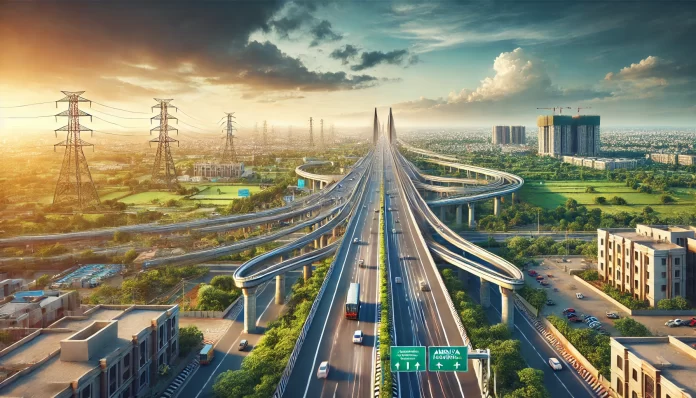The Delhi-Mumbai Expressway is set to revolutionize transportation and connectivity in India, and one of the key beneficiaries is the Amrita Hospital, which is fast becoming a hub for world-class healthcare. With its state-of-the-art infrastructure, this expressway significantly reduces travel time between the two major cities, offering immense benefits for both patients and medical professionals. In this blog, we will explore how the Delhi-Mumbai Expressway is enhancing accessibility to Amrita Hospital, ensuring timely medical interventions and boosting the overall healthcare ecosystem.
A Game-Changer for Connectivity
The Delhi-Mumbai Expressway is a monumental infrastructure project that connects the national capital, Delhi, with India’s financial capital, Mumbai. Spanning over 1,300 kilometers, it is designed to enhance the nation’s road network and stimulate economic growth by improving connectivity. But its advantages go far beyond mere travel time reduction. One of the most significant impacts is on healthcare access, particularly for those seeking specialized treatment at institutions like Amrita Hospital.
Amrita Hospital, located in Faridabad, Haryana, is a beacon of cutting-edge medical services and compassionate care. With the Delhi-Mumbai Expressway making travel more efficient, patients from distant regions now have faster access to this premier healthcare facility. Whether it’s for life-saving surgeries, advanced treatments, or routine check-ups, the expressway plays a crucial role in facilitating timely medical care, especially in emergencies.
Speeding Up the Journey
Before the Delhi-Mumbai Expressway, traveling between Delhi and Amrita Hospital involved long, tedious hours navigating through congested roads and traffic. The expressway, with its modern design, significantly cuts down travel time. For instance, the 3-4 hour journey from Delhi to Amrita Hospital can now be completed in just about two hours, providing substantial time savings for patients, doctors, and families.
Moreover, the Delhi-Mumbai Expressway features multiple lanes, well-maintained roads, and limited entry points, reducing the risk of delays caused by traffic jams or road accidents. This smooth, uninterrupted flow of traffic ensures a much quicker and more reliable trip to the hospital, making a real difference when every second counts in medical emergencies.
Greater Access to World-Class Healthcare
The Delhi-Mumbai Expressway connects several key regions, including towns and cities with significant populations. This means that Amrita Hospital, a renowned institution, becomes even more accessible to people from these areas. People from Rajasthan, Uttar Pradesh, Haryana, and other parts of northern India can now travel more conveniently to avail of the advanced medical care available at the hospital.
In addition to facilitating patient visits, the expressway also encourages collaboration among medical professionals. Doctors, specialists, and healthcare providers from various parts of the country can now commute easily to Amrita Hospital for consultations, conferences, and collaborative projects. This seamless connectivity fosters a stronger healthcare network, where knowledge, resources, and best practices are shared, resulting in better patient outcomes.
Economic Benefits and Infrastructure Growth
The Delhi-Mumbai Expressway is not just a boon for the healthcare sector; its impact extends to regional economic growth. Faster transportation means that goods and services can be transported more efficiently, which in turn helps businesses thrive. For Amrita Hospital, this economic boost translates into better access to medical supplies, advanced equipment, and pharmaceuticals, ensuring that the hospital remains at the forefront of medical technology.
The expressway also plays a role in reducing transportation costs for patients who require follow-up treatments or long-term care at the hospital. By slashing travel time, patients can make multiple visits in a shorter period, making ongoing treatment plans more manageable and affordable.
Improved Emergency Services
In emergency medical situations, time is of the essence. The Delhi-Mumbai Expressway has significantly enhanced the response time for emergency medical services (EMS) heading to and from Amrita Hospital. Ambulances, medical teams, and specialized transport for critical patients can now navigate the expressway more swiftly, ensuring that they reach the hospital in the shortest possible time. This could be the difference between life and death for patients in need of urgent care.
The expressway also supports better coordination between healthcare facilities across the region. When patients are transferred from one hospital to another for specialized treatment, the expressway provides a fast and reliable route, improving the overall healthcare delivery system.
Eco-Friendly Features of the Delhi-Mumbai Expressway
The Delhi-Mumbai Expressway incorporates numerous eco-friendly initiatives, such as dedicated green corridors, rainwater harvesting systems, and advanced waste management practices. These features not only make the expressway more sustainable but also contribute to the health and well-being of the communities it serves. Cleaner air, fewer emissions from traffic, and sustainable infrastructure all create a healthier environment for patients traveling to Amrita Hospital and other nearby medical centers.
Conclusion
The Delhi-Mumbai Expressway is transforming the landscape of healthcare connectivity, particularly for institutions like Amrita Hospital. By drastically reducing travel times, improving access for patients, and enhancing emergency medical services, the expressway is ensuring that individuals across the region can receive timely and world-class care. As this infrastructure project continues to expand, its impact on healthcare delivery will only grow, making it a true lifeline for those in need of medical attention.
